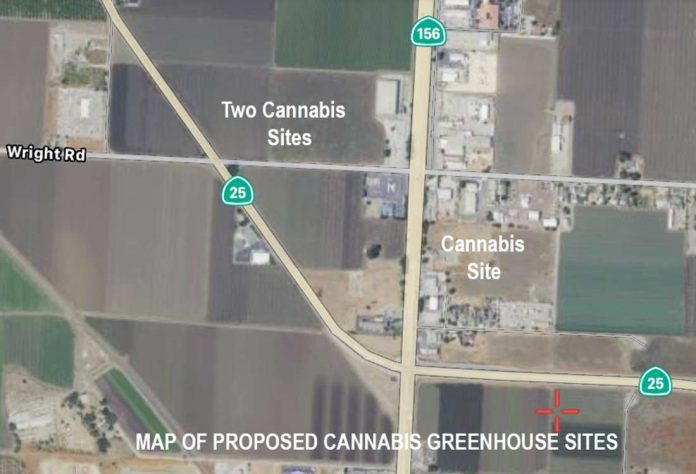
Three proposals at Hollister’s north end would allow construction of more than 1.1 million square feet of cannabis-growing greenhouses and other production facilities, establishing Hollister as an epicenter of cannabis production in the southern Santa Clara Valley and California’s Central Coast.
The planned commercial cannabis developments would be the first “ground-up development” for the city’s exploding new industry, according to developers.
By comparison, the three largest retail shopping malls in the Bay Area—the Great Mall in Milpitas, Westfield Valley Fair in San Jose and the Stanford Shopping Center—range in size from 1.3 to 1.5 million square feet.
Documents filed with Hollister city planners show that the three properties where the cannabis greenhouses are proposed are just north of the intersection of Highway 25 and San Felipe Road.
The three projects are owned by various entities, but are being developed in a single concept by Coats Consulting.
Felipe Nine, LLC for example, plans to construct 220,000 square feet of greenhouses for a cannabis cultivation and manufacturing facility on a nine-acre parcel at 773 San Felipe Road. Just a few hundred feet down the road, an even larger project, Wright Thirteen, LLC, proposes 340,000 square feet of greenhouses on 13 acres for another cultivation facility near the intersection of San Felipe and Wright roads.
Adjacent to Wright Thirteen, the third and largest greenhouse operation, by Briggs Seventeen, LLC, proposes 544,000 square feet of cultivation facilities on 13 acres.
According to Geary Coats of Coats Consulting, land use consultant for the projects, the properties are owned by various owners and partnerships, including Patrick and Chris Orosco of the Orosco Group. The Monterey-based company developed the Target shopping center in Sand City, in addition to various other retail centers in Monterey County, including a dispensary in Seaside.
“This is the first ground-up development for cannabis within the city,” Coats said. “Due to the nascent nature of the legal cannabis industry, there is no ‘normal’ that has been established for facilities; however, this project is a great deal larger than others in Hollister and is among the larger facilities within the state.”
About 34 cannabis businesses, ranging from cultivation to manufacturing facilities, are proposed in Hollister and are in various stages of approval, according to city records.
While the city allows only two dispensaries (one of which, Genesis Marketplace on Shelton Drive, is operational), there is no limit on the number of other types of cannabis licenses that can be issued. According to Hollister’s ordinance, cannabis businesses can only operate in five zoning districts with various setback requirements, such as 600 feet from a school and 150 feet from residences.
The Felipe Nine project, which is currently home to a vacant house and shed, would consist of two indoor cultivation/manufacturing buildings, one that’s 90,000 square feet and another 130,000 square feet. The property also includes a dispensary, which was approved by the city in 2017.
Wright Thirteen, meanwhile, proposes three buildings on vacant agricultural land, ranging from 108,000 square feet to 123,000 square feet.
Lastly, Briggs Seventeen proposes a 544,670-square-foot “warehouse-style structure” in addition to a 64,500-square-foot office space and other facilities on agricultural land that had been producing various crops this past season.
It is unknown how many tenants will occupy the properties, but “ownership has several expressions of interest,” according to Coats.
“I believe the various owners are cooperating with the goal of targeting one or two large operators, but it remains possible that individual parcels may accommodate midsize (vs. large institutional) operators,” he said.
“Demand remains strong for best-of-class facilities such as this that offer greater efficiency and long-term staying power than existing buildings and greenhouses that have been adapted for this use,” he added.
The Briggs Seventeen property requires annexation into city limits, which will be considered by the San Benito County Local Agency Formation Commission at a future date.
Coats said an opening date is targeted for late 2020.
On Dec. 16, the Hollister City Council allowed the mayor to sign development agreements with the three developers. Per the agreements, the city could receive between $450,000 to $1.3 million in annual taxes based on the total square footage of the cultivation area.









